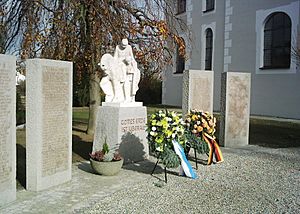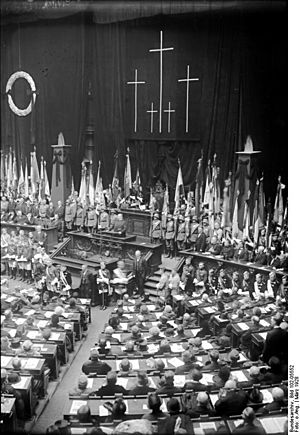Volkstrauertag facts for kids
Quick facts for kids Volkstrauertag |
|
|---|---|
| Observed by | Germany |
| Date | Second Sunday before Advent |
| Frequency | Annual |
Volkstrauertag (which means "people's day of mourning" in German) is a special day in Germany. It happens two Sundays before the start of Advent, which is the time leading up to Christmas.
On this day, people remember and honor those who have died in wars and conflicts. This includes soldiers from all countries and also civilians who lost their lives because of violence or unfair governments. The modern way of observing this day began in 1952.
Contents
The History of Volkstrauertag

Early Days of Remembrance
Back in 1893, the Kingdom of Prussia brought together many different days of prayer. These were celebrated by various Christian groups across German-speaking areas. They created one national holiday called Buß- und Bettag. This day was a work-holiday and was celebrated in November.
After World War I, in 1919, a group called the German War Graves Commission suggested a new day. They wanted a Volkstrauertag to remember German soldiers who died in the war. The first time this day was held was in 1922, in the Reichstag building. By 1926, Volkstrauertag became a regular event. It was often observed on the second Sunday of Lent, a time of reflection before Easter.
Challenges in the Weimar Republic
During the time of the Weimar Republic, Volkstrauertag was not made a legal holiday. There were a few reasons for this:
- It was unclear if the national government (the Reich) or the individual states (the Länder) had the power to create legal holidays. This led to different rules and dates in different parts of Germany.
- The two main Christian churches, Catholic and Protestant, already had their own days in November to remember the dead. They couldn't agree on a new date for Volkstrauertag.
- The Weimar Republic faced political problems. This made it hard to pass new laws, including one for this special day.
The Nazi Era: Heldengedenktag
In 1934, the National Socialists changed Volkstrauertag into a national holiday called Heldengedenktag. This means "Day of Commemoration of Heroes." The focus of the day completely changed. Instead of mourning those who died, it became about celebrating heroes.
The Nazis wanted to promote their ideas of heroism. They also removed Buß- und Bettag as a non-working day. They moved its remembrance to a Sunday to help with their war efforts. The last Heldengedenktag was celebrated in 1945, at the end of World War II.
Modern Volkstrauertag
After World War II, Volkstrauertag returned to its original meaning. It was first observed again in West Germany in 1948. In 1950, the German War Graves Commission held its first big meeting in the Bundestag (German Parliament) in Bonn.
In 1952, the date of Volkstrauertag was changed. It was moved to the end of the church year, a time when people often think about life and death. This also helped to make it different from the Nazi-era Heldengedenktag. The day's meaning was also made wider. It now included not only those who died in war but also people who died because of unfair and violent governments.
How Volkstrauertag is Observed
An official ceremony for Volkstrauertag takes place in the German Bundestag. The President of Germany usually gives a speech. The Chancellor, government ministers, and foreign ambassadors are also there. During the ceremony, the German national anthem is played. The song "Ich hatt' einen Kameraden" ("I had a comrade") is also played. This song is a traditional German military lament.
Most of the German states (Länder) also hold their own ceremonies. Veterans' groups often organize these events. They might include a walk from a church service to a war memorial. There are prayers, speeches from the mayor and veterans' leaders, and a military guard of honor. Wreaths are laid at memorials. Sometimes, an officer from the Bundeswehr (German armed forces) attends as an official representative.
Because of its link to Advent, Volkstrauertag is always on the Sunday closest to November 16th. This means it can fall between November 13th and November 19th.
|


